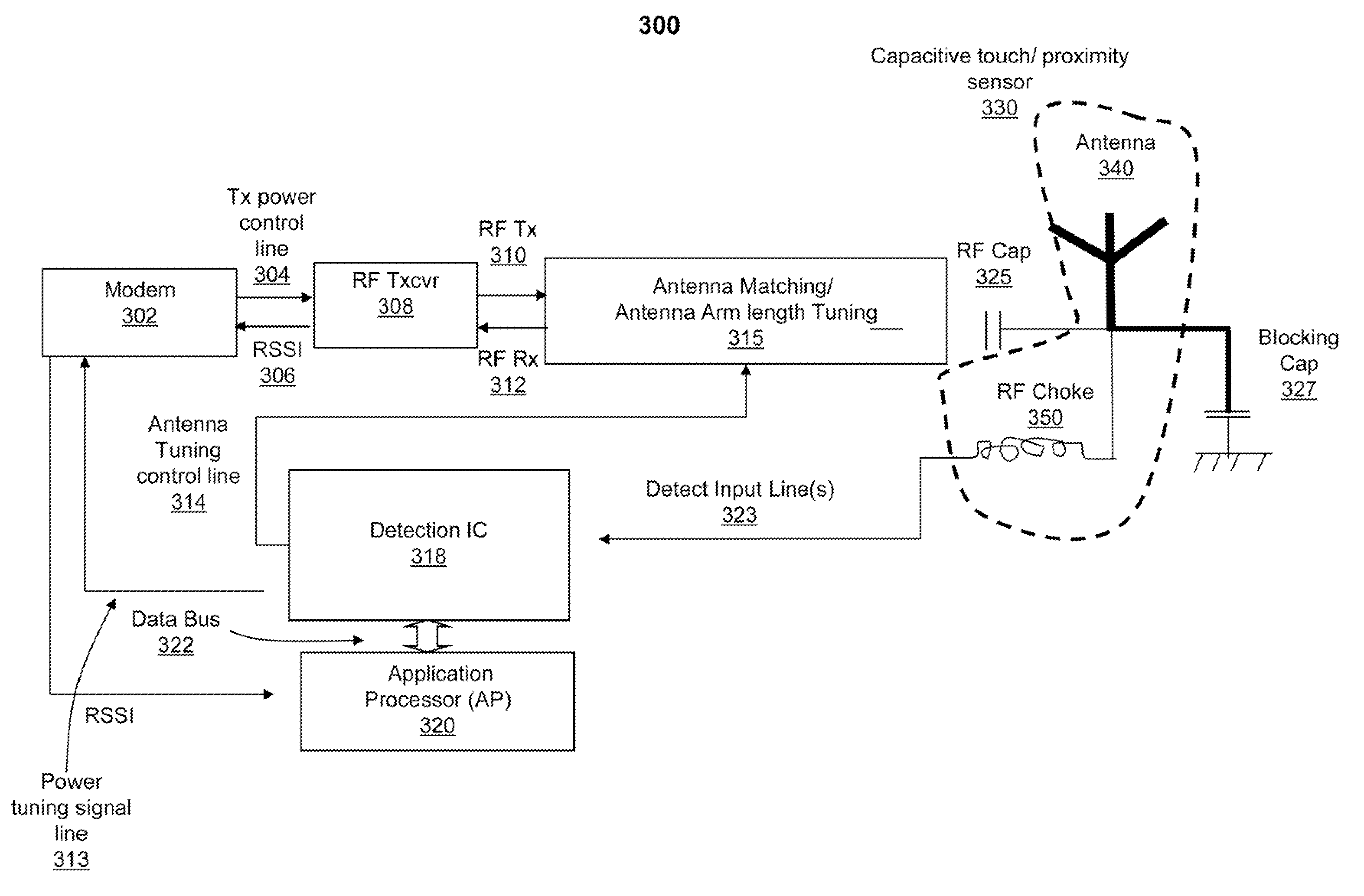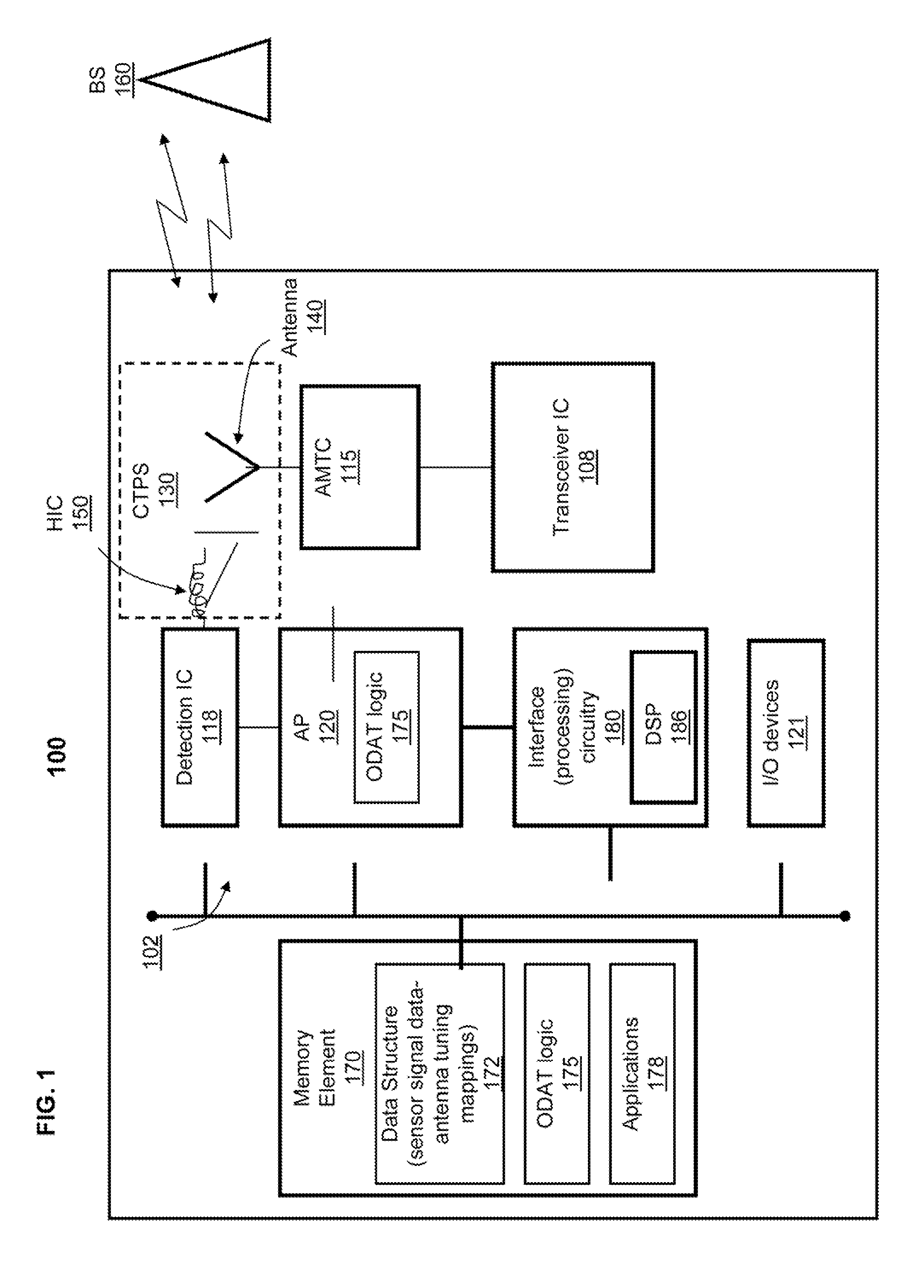Antenna element as capacitive proximity/touch sensor for adaptive antenna performance improvement
- Summary
- Abstract
- Description
- Claims
- Application Information
AI Technical Summary
Benefits of technology
Problems solved by technology
Method used
Image
Examples
second embodiment
[0039]FIG. 3 illustrates a block diagram representation of RFCCs, including a CTPS, in a WCD, according to a RFCC 300 illustrates a second configuration from among several configurations that are presented herein. RFCC 300 comprises AMTC 315 coupled to an output of RF transceiver 308. RFCC 300 also comprises antenna element 340 coupled to an output of AMTC 315 by coupling capacitor 325. Antenna element 340 is RF shorted to ground using a low frequency blocking capacitor 327. Antenna element 340 is further coupled to at least one RF choke 350. Antenna element 340 and RF choke 350 collectively function to provide CTPS 330. Also included within RFCC 300 is detection IC 318 that is coupled to RF choke 350 of CTPS 330. RFCC 300 also includes modem 302 that is coupled to RF transceiver 308. RF transceiver 308 forwards / provides, to modem 302, a RSSI that provides information about RF signal power detected at antenna element 340. Additionally, RFCC 300 comprises AP 320 that is connected by...
third embodiment
[0041]FIG. 4 illustrates a block diagram representation of radio frequency communications components (RFCC), including a capacitive touch and proximity sensor, in a wireless communications device (WCD), according to a RFCC 400 illustrates a third configuration from among the several configurations that are presented herein. RFCC 400 comprises AMTC 415 coupled to an output of RF transceiver 408. RFCC 400 also comprises antenna element 440 coupled to an output of AMTC 415 by coupling capacitor 425. Antenna element 440 is RF shorted to ground using a low frequency blocking capacitor 427. Antenna element 440 is further coupled to at least one RF choke 450. Antenna element 340 and RF choke 350 collectively function to provide CTPS 330. Also included within RFCC 400 is detection IC 418 that is coupled to RF choke 450 of CTPS 430. RFCC 400 also includes modem 402 that is coupled to RF transceiver 408. RF transceiver 408 forwards / provides, to modem 402, a RSSI that provides information abo...
fourth embodiment
[0043]FIG. 5 illustrates a block diagram representation of RFCCs, including a CTPS, in a WCD, according to a RFCC 500 comprises AMTC 515 coupled to an output of RF transceiver 508. RFCC 500 also comprises antenna element 540 coupled to an output of AMTC 515 by coupling capacitor 525. Antenna element 540 is RF shorted to ground using a low frequency blocking capacitor 527. Antenna element 540 is further coupled to at least one RF choke 550. Antenna element 340 and RF choke 350 collectively function to provide CTPS 330. Also included within RFCC 500 is detection IC 518 that is coupled to RF choke 550 of CTPS 530. RFCC 500 also includes modem 502 that is coupled to RF transceiver 508. RF transceiver 508 forwards / provides, to modem 502, a RSSI that provides information about RF signal power detected at antenna element 540. Additionally, RFCC 500 comprises AP 520 that is connected by data bus 522 to detection IC 518. In addition, AP 520 is coupled to an output signal port of modem 502. ...
PUM
 Login to View More
Login to View More Abstract
Description
Claims
Application Information
 Login to View More
Login to View More - R&D
- Intellectual Property
- Life Sciences
- Materials
- Tech Scout
- Unparalleled Data Quality
- Higher Quality Content
- 60% Fewer Hallucinations
Browse by: Latest US Patents, China's latest patents, Technical Efficacy Thesaurus, Application Domain, Technology Topic, Popular Technical Reports.
© 2025 PatSnap. All rights reserved.Legal|Privacy policy|Modern Slavery Act Transparency Statement|Sitemap|About US| Contact US: help@patsnap.com



